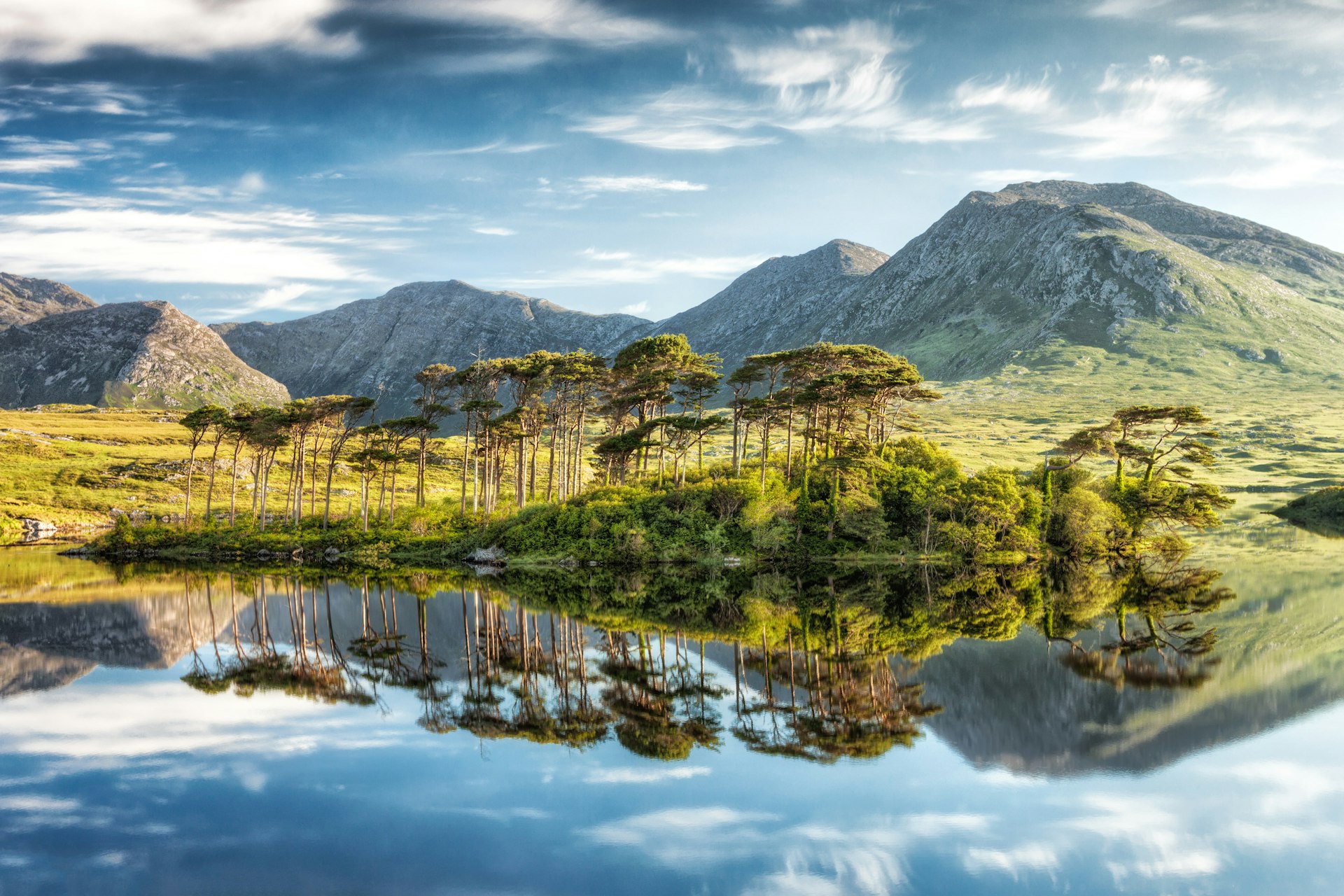
With its famously unpredictable weather, it can be tough to decide the best time to visit Ireland.
The good news is that whatever month you decide to go, you’ll have lots of things to do. With stunning scenery, cozy pubs and a great food culture, there are plenty of highlights to suit every traveler.
Get the inside scoop on the latest cultural happenings all over the world delivered weekly to your inbox with our email newsletter.
The end of October marks the year’s passage of mostly day into mostly night and, keeping in tune with the passing of this season is deeply rooted in the Irish DNA. This is the time of year when things slow down as ferries to the islands scale back their service and smaller restaurants and hotels close for the season. Off-season isn’t the worst time to visit Ireland, though, as there are still plenty of things to see and do during wintertime.
The warmest months from April to August offer endless hours to explore the coastline or lush, rolling green countryside, but with a year-round temperate climate that rarely freezes in winter or blisters in summer, it’s possible to enjoy daytime outdoor activities in any month.
And don’t forget, while waiting for a pint of Guinness to draw or a train to arrive, talking about weather is always a good conversation starter with locals in Ireland. Here, a week of light rain can appear in July while December can offer bright crisp days.
Here’s our guide to help you decide the perfect time to visit Ireland.
 Head to the Ring of Kerry in September or October, and you could dodge the crowds © benedek / Getty Images
Head to the Ring of Kerry in September or October, and you could dodge the crowds © benedek / Getty Images
The September and October shoulder season means harvests and vibrant festivals
Along with springtime, the months of September and October can be the best time to visit Ireland to avoid crowds and save money as prices plummet. Expect long days with mild temperatures and plenty of dry spells to explore the explosion of color throughout Ireland’s national parks and forests. Even the world famous Ring of Kerry, with its dramatic mountainous setting against a vivid ocean backdrop, can be navigated without a convoy of tour buses blocking the views.
Many of Ireland’s best festivals shift into gear at this time. Expect some tasty offerings like the Armagh Food and Cider Weekend or Galway’s International Oyster and Seafood Festival in September. County Cork has the monopoly on October events with the Kinsale Gourmet Festival and Guinness Jazz Festival. A sinister twist brings the month to a close with a spectacular parade at the Galway Aboo Halloween Festival, or visit Dublin, the hometown of Dracula’s creator, to catch the Bram Stoker Festival.
The low season from November to February is the best time for a cheap stay in Ireland
For some, a ramble to a fireside pub in the local village before turning in for the night in a thatched cottage as an Atlantic gale bellows outside is the ultimate romantic getaway. For others it’s the lantern lit cobbled lanes of Ireland’s larger towns like Kilkenny, Limerick or Galway that capture a winter spell in Ireland. They offer good transport links to scenic locations during the day and a wide selection of restaurants and hotels offering low rates to while away the long evenings.
However, with short daylight hours, the occasional storm and icy road conditions, an independent road trip should remain on the motorways. Apart from the heavy hitting tourist attractions like the Cliffs of Moher, The Rock of Cashel, Bunratty Castle or city museums, many of the interpretive centers close for the season, while transport services scale back and remote hospitality goes into winter hibernation.
The holiday season lasts all of December in Ireland, so expect to encounter plenty of Christmas markets like Eyre Square in Galway or The Milk Market in Limerick.
 Celebrate St Patrick’s Day with the rest of Ireland on March 17 © Aitormmfoto / Shutterstock
Celebrate St Patrick’s Day with the rest of Ireland on March 17 © Aitormmfoto / Shutterstock
March is a pricier time to visit because it’s all about St Patrick’s Day
Let’s face it – St Patrick owns March with his very own day on March 17. You should be aware that some locals are a little tetchy about his name so resist the urge to retitle him Patty or Paddy. It’s also the month when tourism and transport stretch wide awake from their winter respite. While weather conditions are still unsettled, the thermometer edges up to 10°C (50°F) and days are much lighter.
The St Patrick’s Day Parade takes center stage in Dublin, Limerick and Cork with floats, jigs, reels and green beer or milkshakes to garnish a diet of sentimental shenanigans and silliness and yes, expect price hikes in hotels for that week. However country parades like the little County Clare procession in Doolin offer a satirical take on the larger events and can be equally rewarding. The wildly successful St Patrick’s global lighting or coloring of sites in green, from the Eiffel Tower to the Sydney Opera House, is predictably rampant in Ireland and can create an atmospheric glow against the limestone render of medieval buildings.
The April to June shoulder season is the best time for golf, flowers and driving along the coast
With temperatures an average high of 18°C (64°F) and prices that haven’t maxed out yet, this is the best time to take a road trip along Ireland’s magnificent Wild Atlantic Way. It’s a 1500 mile sign-posted west coast route that connects Cork in the south to Donegal in the north. It’s also the best time to visit Ireland for golf where you can play on links courses near charming villages, white sandy beaches, coves, castles teetering on cliff tops and vibrant towns like Westport or Sligo.
Blossoms burst into life throughout the country in these months, so take a visit to the garden county, Wicklow, to catch bluebell season at Powerscourt or Glendalough in April. County Clare’s Burren in Bloom festival in May is a great way to see rare species in a spectacular moonscape setting. It can also be the best time to visit Dublin as June kicks off with the Flowers in Bloom Festival shortly before the city hosts Bloomsday on June 16. That’s a celebration of writer James Joyce’s blossoming of a different nature and it’s followed a couple of weeks later with a sea of rainbow flags with the country’s biggest LGBTQ+ Pride Festival.
 Avoid the summer throngs by getting out of the main tourist hubs © Lukasz Pajor / Shutterstock
Avoid the summer throngs by getting out of the main tourist hubs © Lukasz Pajor / Shutterstock
The peak summer season of July and August comes with higher temperatures and crowds
First, the bad news, all Irish schools and colleges are out for summer so in July and August you’re competing with the home market when it comes to accommodations, food, car hire and visitor attractions. That means higher prices and packed beaches (when the sun is out). Last-minute bookings at hotels and restaurants in popular locales are risky.
However, it’s an excellent time to stay on an island like the Arans or Inishbofin, where the bike is the best form of transport. Alternatively Ireland’s lesser seen Midlands are filled with medieval fortresses, blue river trails and quaint villages and they’re crowd free. There’s no better way to explore the area than hiring a boat on the Shannon, the longest river in Ireland, to visit off-radar places like the pretty town of Killaloe, the very Instagrammable high crosses at Clonmacnoise or Sean’s Bar, the oldest pub in Ireland. Boat hire means setting your own independent itinerary, and offers excellent value for money as you’ll sleep on board.
January is quiet
The quietest month of the year, a lull from the holiday festivities as the country gets back to work.
Key event: Temple Bar Tradfest.
February is a good time to visit museums
The perfect month for indoor activities. Some museums launch new exhibits, and it’s a good time to visit the major towns and cities.
Key events: Dublin International Film Festival, Six Nations Rugby.
March is all about St Patrick’s Day
Spring is in the air, and the whole country is getting ready for what is arguably the world’s most famous parade. Dublin is the biggest, but every town in Ireland holds one.
Key event: St Patrick’s Day.
April welcomes festival season
The weather is getting better, the flowers are beginning to bloom and the festival season begins anew. Seasonal attractions start to open up around the middle of the month or at Easter.
Key events: Circuit of Ireland International Rally, Irish Grand National, World Irish Dancing Championships.
 Many sports events keep people entertained through spring © D. Ribeiro / Shutterstock
Many sports events keep people entertained through spring © D. Ribeiro / Shutterstock
May’s weather can be decent
The May Bank Holiday (on the first Monday) sees the first of the busy summer weekends as the Irish take to the roads to enjoy the budding good weather.
Key events: Cork International Choral Festival, Fleadh Nua, Cathedral Quarter Arts Festival, Listowel Writers’ Week.
June is full of festivals
The bank holiday at the beginning of the month sees the country spoilt for choice for things to do. Weekend traffic gets busier as the weather gets better.
Key events: Cat Laughs Comedy Festival, Dublin LGBTQ Pride, Irish Derby, Bloomsday, Cork Midsummer Festival, Mourne International Walking Festival.
July is party time
There isn’t a weekend in the month that a major festival doesn’t take place, while visitors to Galway will find that the city is in full swing for the entire month.
Key events: Willie Clancy Summer School, Galway International Arts Festival, Longitude, Folkfest, All-Ireland Finals.
August is crowded
Ireland is in holiday mode. Seaside towns and tourist centers are at their busiest as the country looks to make the most of its time off.
Key events: Fleadh Cheoil na hÉireann, Galway Race Week, Puck Fair, Rose of Tralee, Kilkenny Arts Festival.
 When the weather is good in Ireland, you can be sure people will make the most of outdoor spaces © D. Ribeiro / Shutterstock
When the weather is good in Ireland, you can be sure people will make the most of outdoor spaces © D. Ribeiro / Shutterstock
September can still have sunny weather
Summer may be over, but September weather can be surprisingly good, so it’s often the ideal time to enjoy the last vestiges of the sun as the crowds dwindle.
Key events: Galway International Oyster & Seafood Festival, Dublin Fringe Festival.
October means Halloween
The weather starts to turn cold, so it’s time to move the fun indoors again. The calendar is still packed with activities and distractions, especially over the last weekend of the month.
Key events: Dublin Theatre Festival, Cork Jazz Festival, Belfast International Arts Festival, Samhain (Halloween).
November can be a cheaper time to visit
A quiet month, the calm before the storm of socializing in December.
Key events: Kilkenomics Festival, Rugby Internationals.
December is full of festive celebration
Christmas dominates the calendar as the country prepares for the feast with frenzied shopping and after-work drinks with friends and family home from abroad. On Christmas Day nothing is open.
Key events: Christmas markets will be open in most cities, towns and villages.



